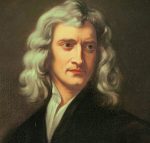Sir Isaac Newton FRS was an English polymath who worked as a mathematician, physicist, astronomer, alchemist, theologian, and author from 25 December 1642 to 20 March 1726/27. He was known in his day as a natural philosopher. He had a significant role in the Scientific Revolution and the ensuing Enlightenment. Many earlier findings were gathered in his groundbreaking book Philosophiae Naturalis Principia Mathematica (Mathematical Principles of Natural Philosophy), which was first published in 1687 and established classical mechanics. Newton co-developed the concept of infinitesimal calculus with German mathematician Gottfried Wilhelm Leibniz, and he made important contributions to optics as well. He is regarded as one of science's greatest and most important figures.
Before the theory of relativity took its place, Newton's Principia contained the laws of motion and the universal gravitation, which constituted the prevailing scientific perspective for centuries. Newton eliminated uncertainty about the heliocentricity of the Solar System by using his mathematical description of gravity to deduce Kepler's laws of planetary motion, account for tides, the trajectories of comets, the precession of the equinoxes, and other phenomena. He showed that the same concepts could be used to explain the motion of objects on Earth and heavenly bodies. The geodetic observations of Maupertuis, La Condamine, and others later corroborated Newton's deduction that the Earth is an oblate spheroid, persuading the majority of European scientists that Newtonian mechanics is superior to earlier theories.
Based on his discovery that a prism divides white light into the visible spectrum's colors, Newton constructed the first useful reflecting telescope and created the theory of color. His very significant book Opticks, which was published in 1704, gathered his work on light. He also developed the idea of a Newtonian fluid, performed the first theoretical estimate of sound speed, and developed an empirical law of cooling. Newton made contributions to the study of power series, extended the binomial theorem to non-integer exponents, created a method for approximating function roots, and categorized the majority of cubic plane curves in addition to his work on calculus.
At the University of Cambridge, Newton served as the second Lucasian Professor of Mathematics and was a fellow of Trinity College. He was a fervent but unconventional Christian who secretly disagreed with the Trinity theory. Unlike the majority of the Cambridge faculty at the time, he declined to receive holy orders in the Church of England. Newton spent a lot of time studying alchemy and biblical chronology in addition to the mathematical sciences, but most of his work in those fields was not published until long after his passing. Newton, who was personally and politically associated with the Whig party, served two brief terms as a member of parliament for Cambridge University, in 1689–1690 and 1701–1702.
life
At Woolsthorpe Manor in Woolsthorpe-by-Colsterworth, a village in the county of Lincolnshire, Isaac Newton was born on Christmas Day, 25 December 1642 (NS 4 January 1643) (according to the Julian calendar then in use in England). Three months earlier, his father, Isaac Newton, had passed away. Newton was a little child when he was born prematurely; according to his mother Hannah Ayscough, he might have fit inside a quart cup. When Newton was three years old, his mother remarried and moved in with the Reverend Barnabas Smith, leaving her son in the custody of Margery Ayscough, Newton's maternal grandmother.
Gravity
Newton resumed his work on celestial mechanics in 1679 and used Kepler's rules of planetary motion to analyze how gravitation affected planet orbits. Afterwards, Hooke, who had been chosen to administer the Royal Society's correspondence, stimulated him with a brief exchange of letters in 1679–1680. Hooke started a correspondence with the aim of getting Newton to contribute to Royal Society transactions. The sight of a comet in the winter of 1680-1681, about which he communicated with John Flamsteed, provided Newton with additional encouragement for his rekindled interest in astronomical topics. Following their discussions, Newton devised a demonstration to show that a centripetal force inversely proportional to the square of the radius vector would cause planetary orbits to take an elliptical shape.
In the De motu corporum in gyrum tract, which was written on around nine sheets and recorded into the Royal Society's Register Book in December 1684, Newton shared his findings with Edmond Halley and the Royal Society. The Principia was formed from the core of this tract, which Newton then extended and expanded.
Halley provided financial support as well as encouragement for the 5 July 1687 publication of The Principia. Newton outlined the three fundamental laws of motion in this work. Together, these principles form the groundwork for classical mechanics by describing the relationship between any object, the forces acting upon it, and the motion that results. They were improved upon for more than 200 years after the Industrial Revolution, which soon after contributed to many advancements. Many of these innovations still serve as the foundation for non-relativistic technologies today. He developed the law of universal gravitation and named the phenomenon that would later be known as gravity using the Latin word gravitas (weight).

